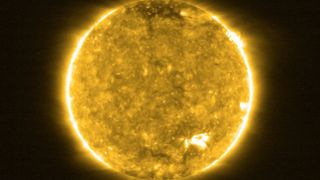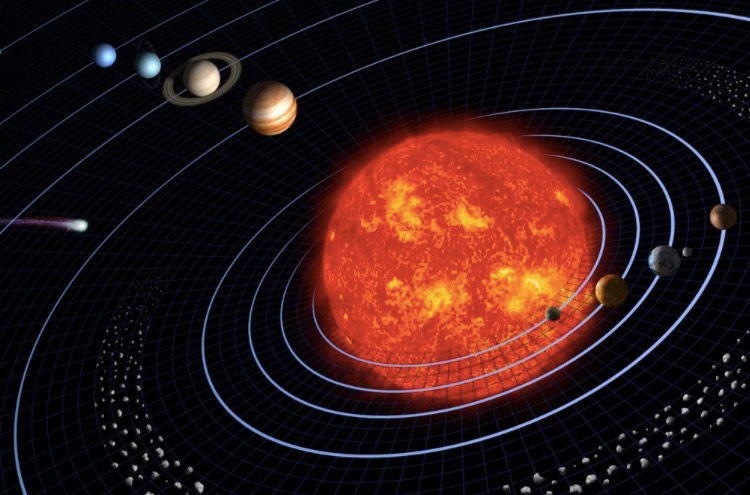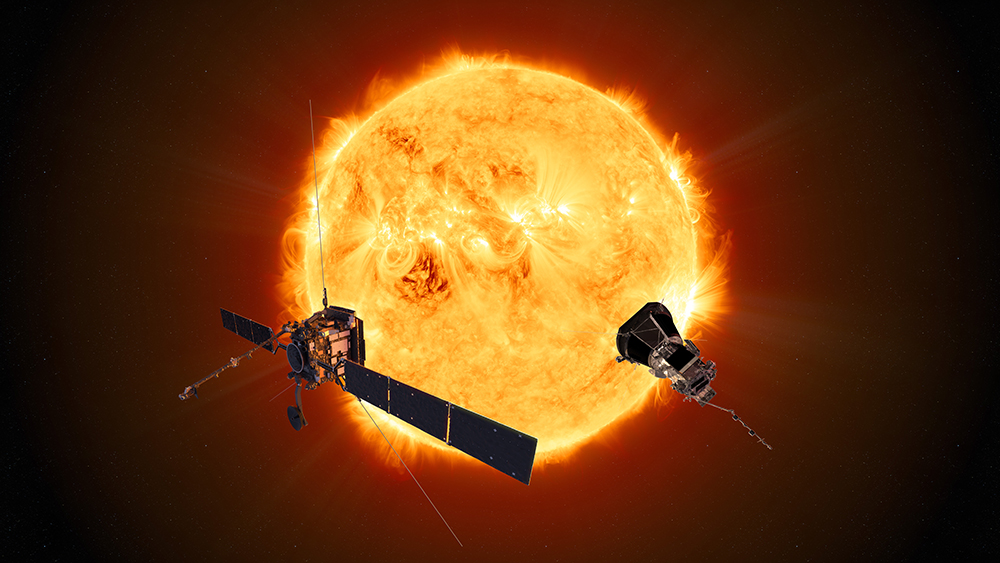How Has The Sun Changed Over Time
Earth's sun: Facts nigh the sun'south historic period, size and history

The sun lies at the heart of the solar system, where information technology is by far the largest object. It holds 99.8% of the solar system's mass and is roughly 109 times the bore of the Earth — almost one one thousand thousand Earths could fit within the sun.
The surface of the dominicus is about ten,000 degrees Fahrenheit (5,500 degrees Celsius) hot, while temperatures in the core reach more than 27 million F (15 million C), driven by nuclear reactions. One would need to explode 100 billion tons of dynamite every second to lucifer the free energy produced by the sun, according to NASA (opens in new tab).
The lord's day is ane of more than 100 billion stars in the Galaxy (opens in new tab). It orbits some 25,000 calorie-free-years from the galactic cadre, completing a revolution one time every 250 1000000 years or so. The dominicus is relatively immature, role of a generation of stars known every bit Population I, which are relatively rich in elements heavier than helium. An older generation of stars is called Population II, and an earlier generation of Population Iii may have existed, although no members of this generation are known nevertheless.
Related: How hot is the sun? (opens in new tab)
How the sunday formed
The sun was born most four.6 billion years ago. Many scientists remember the sun and the rest of the solar system formed from a giant, rotating deject of gas and dust known every bit the solar nebula. Equally the nebula complanate because of its gravity, it spun faster and flattened into a disk. About of the fabric was pulled toward the heart to form the sunday.
Related: How was the sunday formed? (opens in new tab)
The sun has enough nuclear fuel to stay much as information technology is now for another 5 billion years. Later on that, it will swell to become a red giant (opens in new tab). Eventually, it will shed its outer layers, and the remaining core will collapse to become a white dwarf (opens in new tab). Slowly, the white dwarf volition fade, and will enter its terminal phase every bit a dim, absurd theoretical object sometimes known as a black dwarf (opens in new tab).
Related: When will the sunday die?

Internal structure and atmosphere of the sun
The sun and the atmosphere of the sunday (opens in new tab) are divided into several zones and layers. The solar interior, from the inside out, is made up of the cadre, radiative zone and the convective zone. The solar temper above that consists of the photosphere, chromosphere, a transition region and the corona. Across that is the solar wind (opens in new tab), an outflow of gas from the corona.
The cadre extends from the sun's eye to virtually a quarter of the manner to its surface. Although it just makes up roughly ii% of the sun's volume, information technology is near 15 times the density of lead and holds virtually half of the dominicus's mass. Next is the radiative zone, which extends from the core to 70% of the way to the sun's surface, making up 32 % of the sun's volume and 48% of its mass. Low-cal from the core gets scattered in this zone, so that a unmarried photon often may have a million years to laissez passer through.
The convection zone reaches up to the sun's surface, and makes upwardly 66% of the sunday'due south volume but only a niggling more than two% of its mass. Roiling "convection cells" of gas dominate this zone. Two master kinds of solar convection cells exist — granulation cells nearly 600 miles (i,000 kilometers) wide and supergranulation cells nearly 20,000 miles (thirty,000 km) in bore.
The photosphere is the everyman layer of the sun's temper, and emits the low-cal we see. It is about 300 miles (500 km) thick, although most of the low-cal comes from its everyman third. Temperatures in the photosphere range from eleven,000 F (6,125 C) at the bottom to 7,460 F (4,125 C) at the tiptop. Next up is the chromosphere, which is hotter, up to 35,500 F (19,725 C), and is apparently made up entirely of spiky structures known as spicules typically some 600 miles (1,000 km) across and upwardly to 6,000 miles (10,000 km) high.
After that is the transition region a few hundred to a few thousand miles thick, which is heated by the corona above information technology and sheds almost of its light as ultraviolet rays. At the top is the super-hot corona, which is made of structures such as loops and streams of ionized gas. The corona by and large ranges from 900,000 F (500,000 C) to x.8 1000000 F (6 million C) and can even attain tens of millions of degrees when a solar flare occurs. Matter from the corona is blown off equally the solar air current.
Related: Infinite weather: Sunspots, solar flares & coronal mass ejections (opens in new tab)
The sunday's magnetic field
The sunday's magnetic field is typically only most twice as strong every bit World's magnetic field. Notwithstanding, it becomes highly full-bodied in small areas, reaching up to three,000 times stronger than usual. These kinks and twists in the magnetic field develop because the sun spins more rapidly at the equator than at college latitudes and because the inner parts of the sun rotate more speedily than the surface.
Related: Huge magnetic 'ropes' drive powerful sun explosions (opens in new tab)
These distortions create features ranging from sunspots to spectacular eruptions known as flares (opens in new tab) and coronal mass ejections. Flares are the almost trigger-happy eruptions in the solar system, while coronal mass ejections (opens in new tab) are less tearing simply involve boggling amounts of matter — a single ejection can spout roughly 20 billion tons (18 billion metric tons) of affair into space.
Chemical limerick of the lord's day
Just like near other stars, the sunday is made up mostly of hydrogen, followed past helium. About all the remaining matter consists of vii other elements — oxygen, carbon, neon, nitrogen, magnesium, iron and silicon. For every one million atoms of hydrogen in the dominicus, at that place are 98,000 of helium, 850 of oxygen, 360 of carbon, 120 of neon, 110 of nitrogen, xl of magnesium, 35 of iron and 35 of silicon. Still, hydrogen is the lightest of all elements, so it simply accounts for roughly 72% of the sun's mass, while helium makes up well-nigh 26%.
Related: What is the sun made of? (opens in new tab)

Sunspots and solar cycles
Sunspots are relatively cool, dark features on the sun'southward surface that are often roughly circular. They sally where dense bundles of magnetic field lines from the dominicus's interior break through the surface.
The number of sunspots varies as solar magnetic activity does — the change in this number, from a minimum of none to a maximum of roughly 250 sunspots or clusters of sunspots and and so back to a minimum, is known as the solar cycle (opens in new tab), and averages near xi years long. At the end of a cycle, the magnetic field rapidly reverses its polarity.
Related: Largest sunspot in 24 years wows scientists, merely also mystifies (opens in new tab)
History of observing the sun

Ancient cultures often modified natural stone formations or built stone monuments to mark the motions of the sun and moon, charting the seasons, creating calendars and monitoring eclipses. Many believed the dominicus revolved around the Earth, with the ancient Greek scholar Ptolemy formalizing this "geocentric" model in 150 B.C. So, in 1543, Nicolaus Copernicus (opens in new tab) described a heliocentric (sun-centered) model of the solar system, and in 1610, Galileo Galilei (opens in new tab)'south discovery of Jupiter's moons confirmed that not all heavenly bodies circled Earth.
To learn more nearly how the sun and other stars work, after early on observations using rockets, scientists began studying the sun from Globe orbit. NASA launched a serial of eight orbiting observatories known as the Orbiting Solar Observatory (opens in new tab)between 1962 and 1971. Seven of them were successful, and analyzed the lord's day at ultraviolet and Ten-ray wavelengths and photographed the super-hot corona, among other achievements.
In 1990, NASA and the European Infinite Agency launched the Ulysses (opens in new tab)probe to make the first observations of its polar regions. In 2004, NASA'southward Genesis spacecraft returned samples of the solar air current (opens in new tab) to Earth for study. In 2007, NASA'south double-spacecraft Solar Terrestrial Relations Observatory (opens in new tab) (STEREO) mission returned the kickoff iii-dimensional images of the sun. NASA lost contact with STEREO-B in 2014, which remained out of contact except for a brief period in 2016. STEREO-A remains fully functional.
The Solar and Heliospheric Observatory (opens in new tab) (SOHO), which last year celebrated 25 years in space, has been one of the nearly of import solar missions to date. Designed to written report the solar wind, besides as the sunday's outer layers and interior structure, information technology has imaged the construction of sunspots below the surface, measured the dispatch of the solar wind, discovered coronal waves and solar tornadoes, found more than 1,000 comets, and revolutionized our ability to forecast space weather.
The Solar Dynamics Observatory (opens in new tab) (SDO), launched in 2010, has returned never-before-seen details of material streaming outward and away from sunspots, equally well as extreme close-ups of activity on the lord's day's surface and the first high-resolution measurements of solar flares in a broad range of extreme ultraviolet wavelengths.
The newest addition to the sun-observing fleet are NASA's Parker Solar Probe (opens in new tab), launched in 2018, and ESA/NASA Solar Orbiter (opens in new tab), launched in 2020. Both of these spacecraft orbit the lord's day closer than any spacecraft earlier, taking complementary measurements of the environs in the vicinity of the star.
During its shut passes, the Parker Solar Probe dives into the sunday'south outer atmosphere, the corona, having to withstand temperatures hotter than one one thousand thousand degrees Fahrenheit. At its nearest, the Parker Solar Probe will wing merely 4 million miles (6.5 one thousand thousand km) to the sun's surface (the distance betwixt the sunday and World is 93 million miles (150 million km)). The measurements information technology makes are helping scientists learn more almost how energy flows through the lord's day, the structure of the solar air current, and how energetic particles are accelerated and transported.
Related: NASA Parker Solar Probe nails close flyby of lord's day equally its space weather condition cycle ramps upward (opens in new tab)
While Solar Orbiter doesn't fly as close as the Parker Solar Probe, it is equipped with high-tech cameras and telescopes that accept images of the sun's surface from the closest distance e'er. Information technology was non technically possible for the Parker Solar Probe to acquit a camera that would look direct at the lord's day's surface.
At its closest, Solar Orbiter will pass at about 26 million miles (43 million km) abroad from the star — about 25% closer than Mercury (opens in new tab). During its first perihelion, the indicate in its elliptical orbit closest to the sun, the spacecraft approached the lord's day to about one-half the distance from earth. The images acquired during the first perihelion, released in June terminal year, were the closest images (opens in new tab) of the sun ever taken and revealed previously unseen features on the star's surface — miniature flares dubbed the campfires. (opens in new tab)
After Solar Orbiter completes a few close passes, mission controllers will start elevating its orbit out of the ecliptic plane in which planets orbit, to enable the spacecraft'due south cameras to accept the first e'er close-up images of the sunday'southward poles. Mapping the activity in the polar regions volition aid scientists meliorate understand the sun's magnetic field, which drives the 11-yr solar cycle.
This article was updated on June nine, 2021 by Space.com senior writer Tereza Pultarova.
Join our Space Forums to keep talking space on the latest missions, night heaven and more than! And if you lot take a news tip, correction or comment, let us know at: community@space.com.
How Has The Sun Changed Over Time,
Source: https://www.space.com/58-the-sun-formation-facts-and-characteristics.html
Posted by: duartetoneady.blogspot.com


0 Response to "How Has The Sun Changed Over Time"
Post a Comment